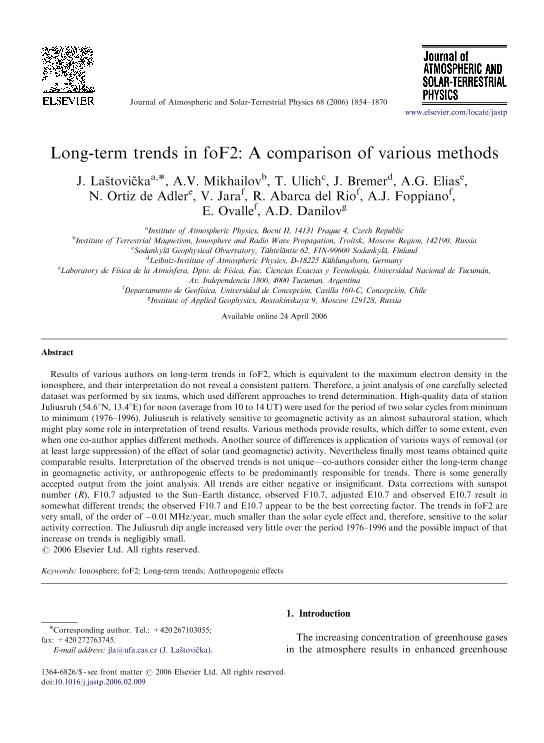Artículo
Long-term trends in foF2: A comparison of various methods
Lastovicka, Jan; Mikhailov, Andrei V.; Ulich, Thomas; Bremer, Jurgen; Elias, Ana Georgina ; Ortiz de Adler, Nieves del Carmen; Jara, V.; Abarca del Rio, Rodrigo; Foppiano, Alberto J.; Ovalle, Elias; Danilov, Andrei D.
; Ortiz de Adler, Nieves del Carmen; Jara, V.; Abarca del Rio, Rodrigo; Foppiano, Alberto J.; Ovalle, Elias; Danilov, Andrei D.
 ; Ortiz de Adler, Nieves del Carmen; Jara, V.; Abarca del Rio, Rodrigo; Foppiano, Alberto J.; Ovalle, Elias; Danilov, Andrei D.
; Ortiz de Adler, Nieves del Carmen; Jara, V.; Abarca del Rio, Rodrigo; Foppiano, Alberto J.; Ovalle, Elias; Danilov, Andrei D.
Fecha de publicación:
12/2006
Editorial:
Elsevier
Revista:
Journal of Atmospheric and Solar-Terrestrial Physics
ISSN:
1364-6826
Idioma:
Inglés
Tipo de recurso:
Artículo publicado
Clasificación temática:
Resumen
Results of various authors on long-term trends in foF2, which is equivalent to the maximum electron density in the ionosphere, and their interpretation do not reveal a consistent pattern. Therefore, a joint analysis of one carefully selected dataset was performed by six teams, which used different approaches to trend determination. High-quality data of station Juliusruh (54.6ºN, 13.4ºE) for noon (average from 10 to 14 UT) were used for the period of two solar cycles from minimum to minimum (1976 ?1996). Juliusruh is relatively sensitive to geomagnetic activity as an almost subauroral station,which might play some role in interpretation of trend results.Various methods provide results,which differ to some extent, even when one co-author applies different methods.Another source of differences is application of various ways of removal (or at least large suppression) of the effect of solar (and geomagnetic)activity.Nevertheless .nally most teams obtained quite comparable results. Interpretation of the observed trends is not unique -co-authors consider either the long-term change in geomagnetic activity, or anthropogenic effects to be predominantly responsible for trends. There is some generally accepted output from the joint analysis.All trends are either negative or insignificant. Data corrections with sunspot number (R, F10.7 adjusted to the Sun -Earth distance, observed F10.7, adjusted E10.7 and observed E10.7 result in somewhat different trends; the observed F10.7 and E10.7 appear to be the best correcting factor. The trends in foF2 are very small, of the order of 0.01 MHz/year, much smaller than the solar cycle effect and, therefore, sensitive to the solar activity correction. The Juliusruh dip angle increased very little over the period 1976 -1996 and the possible impact of that increase on trends is negligibly small.
Palabras clave:
Long-Term Variation
,
Ionosphere
,
F2 Layer
,
Greenhouse Effect
Archivos asociados
Licencia
Identificadores
Colecciones
Articulos(CCT - NOA SUR)
Articulos de CTRO.CIENTIFICO TECNOL.CONICET - NOA SUR
Articulos de CTRO.CIENTIFICO TECNOL.CONICET - NOA SUR
Citación
Lastovicka, Jan; Mikhailov, Andrei V.; Ulich, Thomas; Bremer, Jurgen; Elias, Ana Georgina; et al.; Long-term trends in foF2: A comparison of various methods; Elsevier; Journal of Atmospheric and Solar-Terrestrial Physics; 68; 17; 12-2006; 1854-1870
Compartir
Altmétricas



